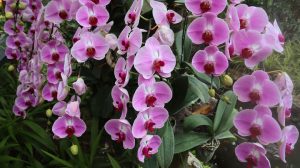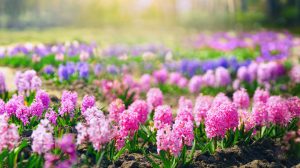Bleeding Heart Leaves, scientifically known as Dicentra spectabilis, are a popular variety of flowering plants that belong to the poppy family. These plants are likely to turn heads with their unique and delicate appearance. The name “bleeding heart” stems from the heart-shaped flowers that dangle from arching stems, which are often pink or white.
The bleeding heart leaves are a key feature of this plant, adding to its overall beauty. The foliage is light green and deeply cut, resembling fern leaves. Some varieties may have a bluish or grayish tint. The leaves are a part of the plant’s life cycle, playing a crucial role in photosynthesis and nutrient absorption.
However, there are instances when bleeding heart leaves may change in color, indicating problems with the plant’s health. Yellowed or wilted leaves could be a sign of insufficient watering or poor soil conditions. In some cases, the leaves may develop small holes or become yellowed and distorted due to insect infestations or fungal diseases.
Treating bleeding heart leaves requires understanding the reasons behind these issues. Proper planting conditions, such as well-drained soil and adequate moisture, are essential for the plant’s health. Providing support for the stems and foliage can also prevent bending or breaking. Regular inspection and maintenance can help identify and address any problems before they become severe.
Often found in woodland areas and natural zones, bleeding heart leaves are naturally attracted to cooler temperatures and moist conditions. In fact, these plants are known to thrive in the Pacific Northwest and other similar regions. However, they are also adaptable and can be grown in various gardening zones.
When the blooming season arrives, bleeding heart leaves give way to beautiful clusters of heart-shaped flowers. The bright pink or white blooms are a stunning contrast against the delicate foliage. These flowers are often described as “bleeding,” with outer petals that curl and fold inward, resembling a heart that appears to “bleed” at the bottom.
Additionally, bleeding heart leaves have attracted gardeners and enthusiasts from around the world. Asian species, such as the Asian Bleeding Heart (Dicentra formosa), offer a unique aesthetic appeal with their pink and red blooms. The presence of such plants in a garden can create a mesmerizing display of color and beauty.
So, whether you are a seasoned gardener or just starting out, consider adding bleeding heart leaves to your garden. Their delicate foliage, stunning blooms, and natural allure will surely captivate all who enter your garden.
Bleeding Heart Has Yellow Leaves Treating Yellow Bleeding Heart Plants
If your bleeding heart plant has yellow leaves, it can be a cause for concern. Bleeding hearts, which are delicate and heart-shaped, are a popular choice in gardening and landscaping. The yellowing of their leaves is not a natural part of their life cycle and likely indicates a problem with the plant’s health.
One reason for yellow leaves on bleeding hearts is insufficient watering. These plants need consistent moisture to thrive, especially during the hot summer season. If the soil is too dry, the leaves may wilt and turn yellow. On the other hand, overwatering can lead to root rot and yellowed foliage as well. It’s important to find the right balance and ensure your bleeding heart receives proper hydration.
Yellow leaves can also be a sign of insect infestation. Bugs like aphids and slugs can damage the foliage, causing it to turn yellow and even develop holes. Inspect your plants regularly for signs of these pests and treat them accordingly. Using natural insect repellents or removing the insects by hand can help restore the health of your bleeding heart.
Frost and cold temperatures can also cause yellowing leaves on bleeding hearts. These plants are native to the Pacific Northwest and prefer mild climates. If you live in areas with harsh winter conditions, your bleeding heart may suffer from frost damage. Protect the plant by covering it or moving it to a sheltered location during the colder months.
Another reason for yellow leaves on bleeding hearts is planting them in unsuitable conditions. These plants prefer partial shade and well-drained soil. If they are exposed to full sun or soggy soil, their leaves can become yellow and damaged. Adjusting the lighting and soil conditions can help improve the health of your bleeding heart.
Some species or varieties of bleeding hearts naturally have yellowish or variegated foliage. If this is the case with your plant, there is no cause for concern. However, if your bleeding heart previously had green leaves and they have recently turned yellow, it may be a sign of an underlying issue that needs attention.
To prevent yellow leaves on bleeding hearts, provide adequate watering, protect them from extreme temperatures, and ensure they are planted in suitable conditions. With the right care and support, your bleeding heart plants can maintain their beautiful foliage and bloom season after season.
Naturally Yellowing Bleeding Hearts
Bleeding hearts are delicate, heart-shaped flowers that naturally have bright pink blooms. However, in some cases, these flowers can turn yellow. There are several reasons why bleeding hearts may become yellowed, such as disease, insufficient moisture, or insect problems.
One possible reason for yellowing bleeding hearts is a fungus called downy mildew. This disease can enter the plant through holes in the foliage and cause the leaves to turn yellow. In addition to downy mildew, bleeding hearts can also be attracted to other types of fungal problems, such as powdery mildew. These diseases can cause the foliage to wilt and turn yellow or brown.
Another common reason for yellowing bleeding hearts is insufficient moisture. Bleeding hearts are native to woodland areas and prefer moist soil conditions. If the soil becomes too dry, the leaves and stems can wilt and turn yellow. To prevent this, make sure to water the plants regularly and maintain proper soil moisture.
Some bleeding heart species, such as the Asian variety, may naturally have yellow or yellow-green foliage. These plants can still produce vibrant pink blooms, but their leaves will remain yellow throughout the growing season. If your bleeding heart has naturally yellowing foliage, there is no need to worry as it is part of their normal life cycle.
Insect problems can also cause yellowing in bleeding hearts. Leaf-eating insects, like aphids, can cluster on the leaves and cause them to yellow. Additionally, if the stems are damaged by bugs or other factors, it can lead to yellowing of the leaves.
Yellowing bleeding hearts can also be a result of changing seasons. As the temperature drops or lighting conditions change, the leaves of bleeding hearts may naturally yellow and fall off. This is especially common in the Pacific Northwest, where the cool, wet winters can cause the foliage to turn yellow.
If your bleeding heart leaves are yellowed, it’s important to diagnose the underlying cause before treating the plants. Once you know the reason for the yellowing, you can take appropriate steps to support the plants and help them return to their vibrant, green state.
Other Reasons for Bleeding Heart Leaves Turning Yellow
While insufficient heat and light can cause bleeding heart leaves to turn yellow, there are other reasons for this discoloration as well. One such reason is fungal disease, especially in areas with moist conditions or where the plant has been overwatered. The fungus may enter small holes in the plant’s leaves, causing them to yellow and wilt. Treating the fungus with a fungicide and improving the plant’s drainage can help prevent further yellowing.
Insect problems are another likely cause of yellowing bleeding heart leaves. Some species of bleeding hearts are naturally attracted to woodland areas, and insects such as aphids or leafhoppers can feed on the plant’s foliage. These pests can cause the leaflets to become yellowed and damaged. Using insecticidal soaps or natural predators can help control these pests and prevent further damage to the leaves.
Additionally, environmental factors can contribute to yellowing leaves. Bleeding hearts prefer cool temperatures and thrive in USDA hardiness zones 3 to 9. If the temperatures are too hot or the plant is exposed to too much direct sunlight, the leaves may yellow and wilt. Providing shade or planting the bleeding heart in a cooler area can help support its delicate foliage.
Finally, some bleeding heart varieties naturally have yellow leaves. For example, the Pacific bleeding heart, with its bright yellow heart-shaped blooms, has naturally yellow foliage. This variety is a natural hybrid of the Asian species and has adapted to the bright sunlight of the Pacific Northwest, including areas such as Portland. If the yellowing leaves are accompanied by healthy blooms, then this may be the natural coloration of the plant’s foliage and not a sign of disease or stress.
Insufficient Watering
One of the reasons why Bleeding Heart Leaves may turn yellow is insufficient watering. This delicate species requires adequate moisture to support its lush foliage and blooms. If the soil becomes too dry, the plants will show signs of stress, such as yellowed and wilted leaves. This can happen especially during periods of high heat or if the plants are planted in areas with poor drainage.
To prevent insufficient watering, make sure to water your Bleeding Heart plants regularly, especially during hot and dry conditions. Water deeply so it reaches the plant’s root system. Additionally, using natural mulch, such as moss or wood chips, can help retain moisture in the soil, keeping the plants hydrated.
If your Bleeding Heart Leaves have already yellowed due to insufficient watering, you can try treating the plants by increasing the frequency of watering and ensuring the soil remains consistently moist. However, be cautious not to overwater, as this can lead to other problems such as root rot.
In some cases, yellowing of Bleeding Heart Leaves can also be caused by disease or insect infestation. Fungus and bugs can enter the plants through small holes or cuts on the leaves, which are more likely to occur if the plants are stressed due to insufficient watering. To avoid these issues, maintain good gardening practices by providing proper lighting conditions, avoiding overcrowding of plants, and regularly inspecting the foliage for signs of pests or diseases.
In hotter climates or zones with higher temperatures, Bleeding Heart Leaves may turn yellow and wilt more easily. Providing adequate shade and planting the species in woodland areas or areas with cooler temperatures can help prevent excessive water loss and maintain the health of the plants.
Overall, ensuring sufficient watering is crucial for the health and vibrancy of Bleeding Heart Leaves and blooms. By providing the right amount of moisture, you can help this beautiful and delicate species thrive in your garden or outdoor space.



